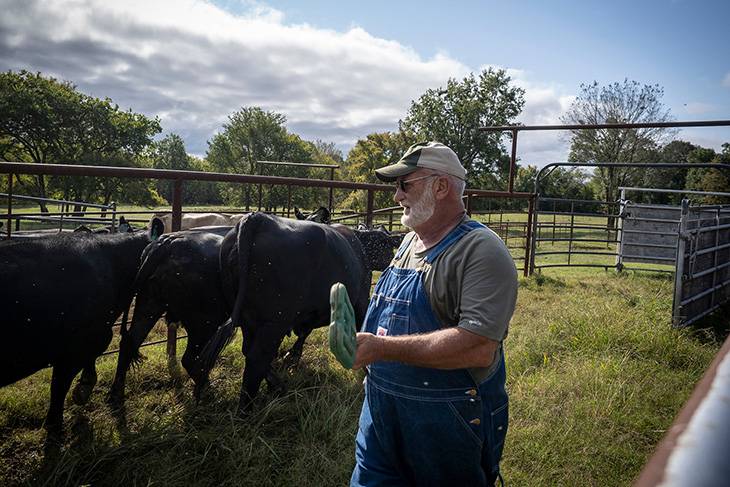Oklahoma State recommendations provide useful guidelines for cow culling
Tuesday, October 6, 2020
Oklahoma cattle producers Larry Cochran of Alfalfa County and Ted Evicks of Latimer County are culling cows with specific animal-productivity objectives in mind, as directed by Oklahoma State University recommendations.
Cull cows represent approximately 20% of the gross income of any commercial cow operation, underscoring the importance of making sure cow culling is done properly and profitably, said Glenn Selk, OSU Extension emeritus animal scientist and managing editor of the university’s popular Cow-Calf Corner newsletter and SUNUP television segment.
Cochran employs both spring and fall calving seasons in his operation. His preference is not to buy first-calf heifers but focus on infusing his herd with young cows when needed.
“I prefer to buy proven cows and keep them four or five years while closely monitoring their health, body condition and whether or not they are good breeders,” Cochran said. “My herd breeding program is designed to produce bald-faced calves from live bulls.”
OSU animal science recommendations are standards to which Cochran and his wife adhere when it comes to their cow-calf operation, including culling open cows, cows with bad udders, cows with demonstrable health issues and cows that may not be viable for another year.
“We emphasize pasture and overall feed management in our no-till operation, and so our cows typically are in good body condition,” Cochran said.
Generally, emaciated cattle have lightly muscled carcasses with extremely small ribeyes and poor red-meat yield. This greatly lessens the salvage value of such animals. Just as importantly, emaciated cattle are most often those which collapse in transit, as they lack the energy to remain standing for long periods of time.
Studies have shown that severe bruising, excessive carcass trim, increased condemnations and even death are the net results of emaciation. Cow carcasses condemned at the packing plant are a monetary drain for the entire beef industry.
Thin cows have a low dressing percentage, which is the weight of the carcass divided by the live weight of the animal. Thin cows also weigh less. These two factors are primary reasons why thin cull cows return fewer dollars at sale time than if they were sold in moderate body condition.
“Producers may want to place their cull cows in a drylot with a high-quality feed for 45-60 days,” Selk said. “The cows become less efficient at converting feed to body weight after about 60 days and the market will not pay for excessive fatness, so more than 60 days will not pay off for a producer.”

Selk recently spoke about specific considerations for culling cows on the OSU Extension agricultural television program SUNUP, available for viewing online.
Evicks, a retired OSU Extension agricultural educator with Pittsburg and Haskell counties, makes extensive use of the research-based recommendations he provided to producers for decades, especially when it comes to getting his local veterinarian involved.
“A good working relationship with your local veterinarian is an investment in risk management, often helping to identify potential issues before they become costly problems,” he said. “It’s more than just culling open cows, which you want to do before spending money on their winter feed bill. We pay particular attention to the health of the animal’s eyes, feet and legs.”
Cows with foot rot infections or arthritic joints may be subject to substantial carcass trimming when they reach the packing plant. They will be poor producers if allowed to stay on the ranch while severely lame. Culling them will help reduce the loss of sale price that may be suffered later.
Heavy wart infestations and pinkish growths on the upper, lower or corner eyelids can become cancerous if left unchecked. Culling affected cows while growths are small should allow the animal to be utilized normally. If cancer engulfs the eyeball and gets into the lymph nodes around the head, the entire carcass likely will be condemned as not fit for human consumption.
“Adjusting for age can be tricky in terms of cow culling as there is great variability in the longevity of beef cows, but OSU has useful guidelines based on research,” Selk said.
Data from large ranches in Florida indicate that cows are consistent in their rebreeding performance through about eight years of age. A small decline was noted afterward with the most consistent decline in reproductive performance noted after cows were 10 years of age. A steeper decline in reproductive performance was found as they reached 12 years of age.
OSU Extension is one of two state agencies administered by the university’s Division of Agricultural Sciences and Natural Resources and is a key part of OSU’s state and federally mandated teaching, research and Extension land-grant mission.
MEDIA CONTACT: Donald Stotts | Agricultural Communications Services | 405-744-4079 | donald.stotts@okstate.edu
